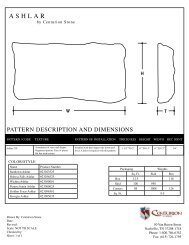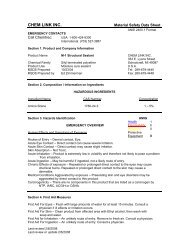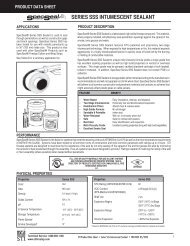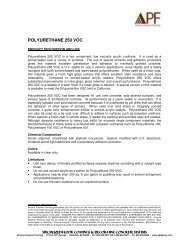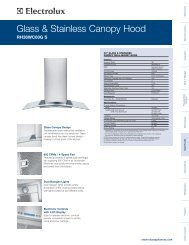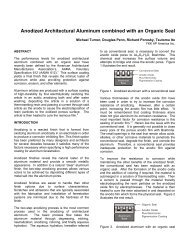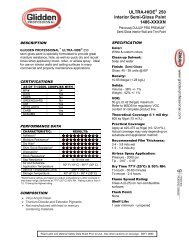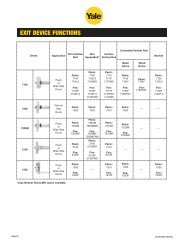Study of CPVC Taste, Odor and Leach...
Study of CPVC Taste, Odor and Leach...
Study of CPVC Taste, Odor and Leach...
You also want an ePaper? Increase the reach of your titles
YUMPU automatically turns print PDFs into web optimized ePapers that Google loves.
Results comparing the polymer materials indicated<br />
that <strong>CPVC</strong> imparted the fewest organic compounds<br />
to the water, consumed the least amount <strong>of</strong><br />
disinfectants, <strong>and</strong> produced no noticeable odors.<br />
All other polymer materials imparted distinct<br />
odors <strong>and</strong> organic chemicals into the water <strong>and</strong><br />
were shown to consume residual disinfectant.<br />
Of all the materials tested, epoxy lining had the<br />
most dramatic effect on water quality, imparting a<br />
moderate “plastic-putty-glue” odor, leaching 0.4-<br />
0.6 mg/L organic carbon including the compounds<br />
bisphenol A, styrene, toluene, nonylphenol <strong>and</strong><br />
benzaldehyde. It also consumed nearly all the<br />
residual chlorine <strong>and</strong> chloramines.<br />
In contrast, HDPE consumed a low amount <strong>of</strong> residual disinfectant <strong>and</strong><br />
released only about 0.1 mg/L organic carbon to the water including<br />
phenol, bisphenol-A, tetradecane, cyclohexadiene, cyclohexanone, <strong>and</strong><br />
cyclopentanone. The overall odor imparted to the water from HDPE<br />
had a moderate intensity <strong>and</strong> was described as “waxy/plastic/citrus.”<br />
Panelists described the HDPE odor as “chemical/plastic” in the presence<br />
<strong>of</strong> chlorine <strong>and</strong> “waxy-crayon/plastic” in water with chloramines. The<br />
presence <strong>of</strong> disinfectants did not appear to alter the intensity <strong>of</strong> the<br />
odors. Despite their overall similarities, various PEX piping products<br />
performed differently in the tests, with some pipe producing more<br />
odors than others. Water in contact with the best performing PEX<br />
product possessed weak to moderate intensity odors, leached about<br />
1 mg/L organic carbon, <strong>and</strong> consumed up to 0.5 mg/L free chlorine.<br />
Ethyl-t-buyl ether (EtBE) was found to contribute significantly to the<br />
characteristic “burning-solvent/plastic” odor <strong>of</strong> the better performing<br />
PEX pipe.<br />
The Lubrizol Corporation<br />
Parameter<br />
(short-term testing) <strong>CPVC</strong> HDPE<br />
Increased <strong>Odor</strong>s<br />
– sensory annoyance<br />
Organic Carbon Release<br />
Chlorine Consumption<br />
Chloramine Consumption<br />
As for copper, the results indicate that it consumed<br />
nearly all the residual disinfectant but released few<br />
organic compounds or odors.<br />
The below table summarizes the impacts <strong>of</strong> the<br />
various polymer piping materials on both the sensory<br />
(taste <strong>and</strong> smell) <strong>and</strong> chemical quality <strong>of</strong> drinking<br />
water. It is interesting to note that while some<br />
materials performed well in certain categories, they<br />
under-performed in others. The best-performing<br />
PEX pipe, for example, leached the greatest amount<br />
<strong>of</strong> organic carbon, as well as the greatest number <strong>of</strong><br />
volatile organic compounds, but did not contribute<br />
the most intense odors (although it did contribute<br />
a variety <strong>of</strong> odors). HDPE leached only a minor<br />
amount <strong>of</strong> organic carbon (but many specific organics) yet imparted the<br />
greatest odor intensity.<br />
Impact on Drinking Water Quality<br />
Only <strong>CPVC</strong> performed consistently well across the categories. Not only<br />
did it leach the least amount <strong>of</strong> Total Organic Compounds (TOC) <strong>and</strong><br />
have the fewest number <strong>of</strong> compounds identified by SPME-GC-MS, but<br />
it also had the least impact on water aesthetics, which meant there was<br />
no <strong>of</strong>fensive taste or smell to water flowing through <strong>CPVC</strong> piping. Not<br />
only does this conclusion support the selection <strong>of</strong> <strong>CPVC</strong> but it suggests<br />
that it is the specific organic chemicals <strong>and</strong> not the concentration <strong>of</strong><br />
organic carbon present in the water that determines odor intensity <strong>and</strong><br />
aesthetic impact. Additionally, there did not appear to be any correlation<br />
between the type <strong>of</strong> disinfectant <strong>and</strong> amount <strong>of</strong> organic carbon leached.<br />
Both chlorine <strong>and</strong> monochloramine had minimal effect on the intensity<br />
<strong>of</strong> the odors associated with the polymer.<br />
Best<br />
Performing<br />
PEX<br />
Worst<br />
Performing<br />
PEX<br />
Epoxy Copper<br />
1 5 2 4 5 3<br />
1 1 2 5 3 1<br />
1 2 1 1 5 5<br />
1 2 1 1 5 5<br />
(1 indicates least impact to water quality; 5 indicates greatest impact)<br />
FGGTECHS






